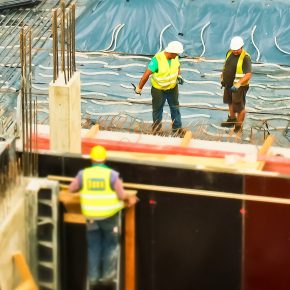
GUEST ARTICLE: Using Technology To Improve Safety At Construction Sites
Whether it was construction in the early 90s or the present day, safety at construction sites has always stayed to be the primary focus of construction contractors.
Thanks to the advanced technology as it has helped the construction industry to come a long way in improving safety practices while making it more practical and achievable to meet the defined standards. However, there is still a large community of construction contractors who resist adopting these modern safety solutions.
Though it is natural to have a hesitation on adopting the new technology because of its unfamiliar realm, the inability to adapt with modern safety tools and technology could cause a big-time loss of opportunities. This is because most general contractors and project owners prefer to work with firms that are recognised for their technology and work practices that can offer maximum reliability, safety, and productive construction.
Since it is vital for construction companies to understand the need for safety while planning for modern construction projects, Ed Williams, Senior Team Lead at ProjectPro, brings you a list of technologies with clear detail on how they can help construction professionals to improve project safety in the near future.
Robotics and Automation
Automation is the technology that has extended its presence in almost every industry. From routine operations to critical construction tasks, automation can prove to be a great tool for improving safety.
Moreover, automating construction projects can not only offer safety but can also prevent the loss of 31.2 million working days happening globally within the construction industry every year. Besides this, automation and robotics technology could also help contractors to simplify tasks like moving heavy objects and masonry activities with more precision and timeliness.
Wearable Technology
The next big thing that can be done to improve construction safety is increasing the use of wearable technology.
Especially when the world is facing the COVID-19 pandemic, wearables can be used to keep the workers alert of the social distancing norms while at the same time, the devices can be used to monitor important health data such as body temperature, heart rate, blood oxygen level, etc. of the workers.
Apart from this, the technology can help detect fatigue in employees overcoming any chances of accidents that might happen with sleepy workers.
Smart Protective Equipment
At third, we have smart protective equipment. Since 2020 was a year that made PPE or Personal Protective Equipment a common to hear the term for all, the construction industry could leverage the equipment for safety for the present and the future. With the protective clothing market likely to grow further in 2022, the scope of connectivity features and sensors with the equipment could offer great security benefits to the construction firms.

For instance, the technology can be put to use on detecting heat levels, UV radiation, air quality, or any other environmental or physical factors that can have a direct negative impact on health. Moreover, the use of smart technology like AR can be done to make safety glasses more effective during activities where it is extremely difficult to watch and work. Though the present application of the technology is limited, it can actually offer great safety benefits to construction firms in the near future.
Online Databases
The next thing that can be done to improve safety with construction projects is implementing an online database for the business. This can be done by using cloud-based construction management software that can keep all the business data centralized and secure for ensuring financial and project safety.
Moreover, using such a system can help to keep data sorted to prevent any safety issues that are likely to occur at the construction site. Also, using a dedicated data management solution can cut all the downtime that can happen at the site affecting the financial safety as well as the operational performance of the project.
Smart Sensors
Last but not least, construction firms and contractors could rely more on smart sensors that are meant to control accidents at the job site. Whether it be the measuring of air quality index or temperature variations at the site, these sensors could aid contractors to avoid any unexpected incidents that might happen at the workplace.
Apart from this, the sensors can be incorporated into PPE or other equipment to implement a new form of digital safety. For instance, tagging workers and equipment with sensors could help avoid unwanted collisions or accidental hits by the equipment made to the workers who are working at critical areas of the construction site. Moreover, these sensors can be allowed to identify any hurdles that the equipment may encounter during the construction process.
The Crux
Construction is one of the oldest practices, probably came into existence along with humanity. However, the concepts and techniques of construction do not need to stay the same. rather they must be upgraded from time to time to ensure a safe and proactive environment that does not involve any fatalities or accidents.
All in all, the use of digital tools, equipment, software, and technology can effectively reduce such incidents while allowing project owners to enjoy improved revenue with productive construction.
So, if you are a construction contractor struggling with inefficient safety practices, then you have to understand that there is no time better than now to upgrade and adapt technology-based safety practices.
Latest news

15th April 2025
West Fraser: CaberDek earns top marks from Home Counties carpentry specialist
A specialist carpentry sub-contractor covering housing sites across a large swathe of the Home Counties has come to value CaberDek from the West Fraser range for a variety of reasons: not least because the high quality panel product doesn’t destroy his operatives’ electric saws!
Posted in Articles, Building Industry News, Building Products & Structures, Building Systems, Case Studies, Restoration & Refurbishment, Retrofit & Renovation, Roofs, Timber Buildings and Timber Products, Wooden products
15th April 2025
GEZE: The Role of Access Control Systems in Enhancing Building Safety
Jane Elvins, Specification and Business Development Manager at GEZE UK, delves into the role of access control systems in enhancing building safety…
Posted in Access Control & Door Entry Systems, Architectural Ironmongery, Articles, Building Industry News, Building Products & Structures, Building Services, Doors, Facility Management & Building Services, Health & Safety, Restoration & Refurbishment, Retrofit & Renovation, Security and Fire Protection
11th April 2025
Don’t Do a Dave! It’s Time to Lock FIT Show 2025 in Your Calendar!
It’s that time again – FIT Show is back! You could be forgiven for thinking there won’t be much new to see when FIT Show returns to the NEC from 29 April – 1 May. Wrong!
Posted in Articles, Building Industry Events, Building Industry News, Building Products & Structures, Building Services, Continuing Professional Development (CPD's), Exhibitions and Conferences, Information Technology, Innovations & New Products, Restoration & Refurbishment, Retrofit & Renovation, Seminars, Training
11th April 2025
Insight Data: Boost construction success with project and prospect data
For those working in construction – in whatever capacity – the last few years haven’t been much fun. And according to the latest statistics, it would seem the challenges are continuing – Alex Tremlett, Insight Data’s Commercial Director, has more…
Posted in Articles, Building Industry News, Building Services, Information Technology, news, Research & Materials Testing
 Sign up:
Sign up: